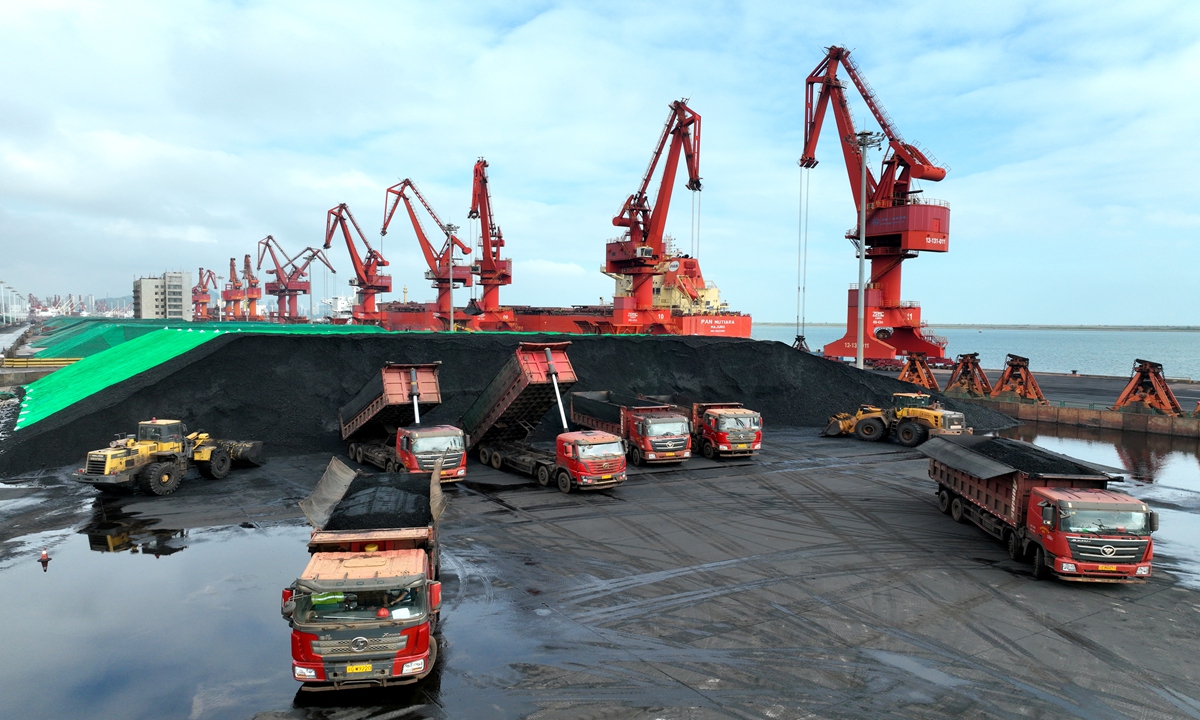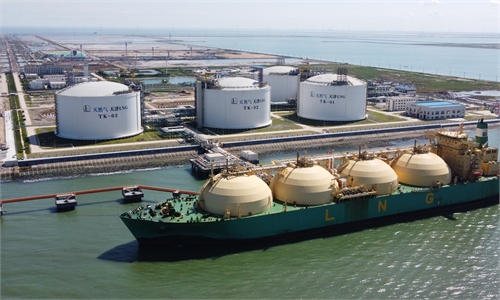
Large machines stack thermal coal on trucks after it's unloaded from a ship at a port in Lianyungang, East China's Jiangsu Province, on July 18, 2022. Lianyungang port has opened a green channel for thermal coal transportation that's open 24/7 in a bid to ensure electricity generation in surrounding power plants. Photo: cnsphoto
After meeting market demand for energy during the consumption peak in summer, Chinese provinces have stepped up measures to prepare for growing electricity use in winter by increasing coal output, simplifying railway freight transportation, and ramping up the volume of power generated from new-energy sources.
As temperatures have dropped in many parts of the country, some localities, such as Northeast China's Heilongjiang Province and North China's Inner Mongolia Autonomous Region, started providing heating ahead of the usual time of mid-November. As a result, energy demand is rising.
Ministries and provinces have worked out plans to ensure sufficient energy supply. The National Energy Administration, for instance, said that it will have a system ready for the daily dispatch of coal output nationwide and a mechanism to monitor prices and inventories.
Southwest China's Sichuan Province, where hydropower accounts for about 80 percent of local energy supply, reached a cooperation deal with Northwest China's Shaanxi Province on October 10 on power supply sharing, which will be valid until the end of 2023. Thermal power accounts for nearly 70 percent of Shaanxi's power, which means that Sichuan and Shaanxi are highly complementary.
Since the implementation of the energy supply policy last year, the situation has now improved, Lin Boqiang, director of the China Center for Energy Economics Research at Xiamen University, told the Global Times.
Coal producers have increased output to ensure supply. In the first three quarters, the output of industrial raw coal by enterprises above designated size was 3.32 billion tons, up 11.2 percent year-on-year, according to statistics released by the National Bureau of Statistics (NBS) on Monday.
The fourth quarter is the peak season for coal use. In addition to heating, coal supplies for power generation also need to be guaranteed, a veteran industry insider told the Global Times on Tuesday.
"This winter, it's unlikely we'll see power outages seen last year. One of the most important reasons is the implementation of the electricity price mechanism reform, which enhanced the willingness of thermal power enterprises to produce electricity," said the insider, noting that the increased connection of new-energy sources with power grids also helps ease power shortage.
In the first three quarters, industrial power use reached 6.3 trillion kilowatt-hours (kWh), up 2.2 percent year-on-year. Thermal power generation stood at 4.4 trillion kWh, an increase of 0.5 percent, while clean energy sources, such as hydropower, nuclear power, wind power and solar power, generated 1.9 trillion kWh, up 6.5 percent, NBS data showed.
"On the whole, there is no problem with energy supply this winter and next spring. But there is a chance that extreme weather might disrupt rail transport," said Lin.
China Railway said that more coal-carrying trains were added starting October 11.
The Datong-Qinhuangdao Railway, which links Datong in North China's Shanxi and Qinhuangdao in North China's Hebei Province, will extend its autumn overhaul until Saturday to ensure smooth coal transportation.
The railway is responsible for nearly one-quarter of the coal transportation in China. It provides the coal transportation for six national-level power grids, more than 350 major power plants, and 10 major iron and steel enterprises.
Although the current thermal coal inventory is relatively high, all power plants should strive for a relatively high inventory level, in case extreme weather disrupts coal transportation, read a statement released by the China Electricity Council on Monday.



